高考常用词汇辨析1
图片预览
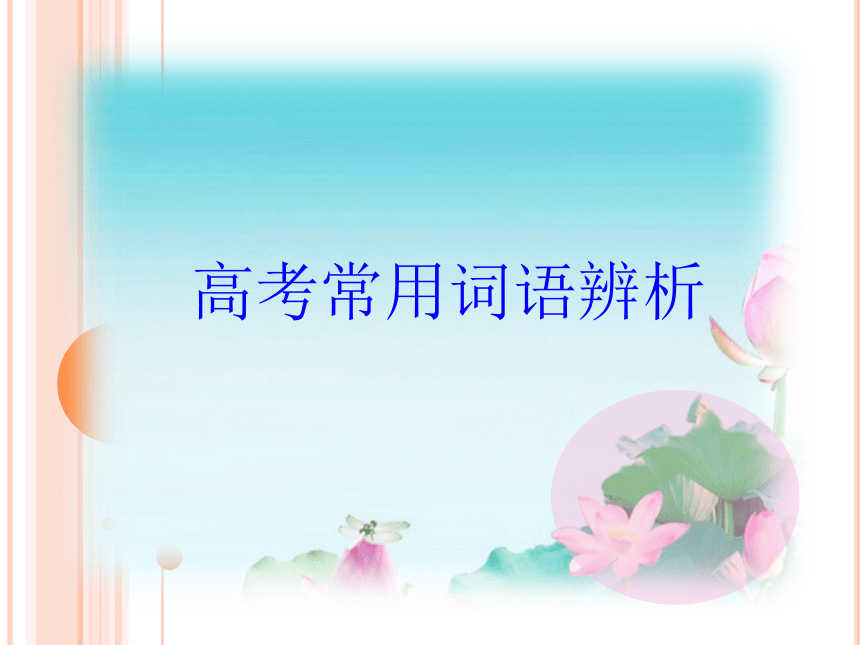
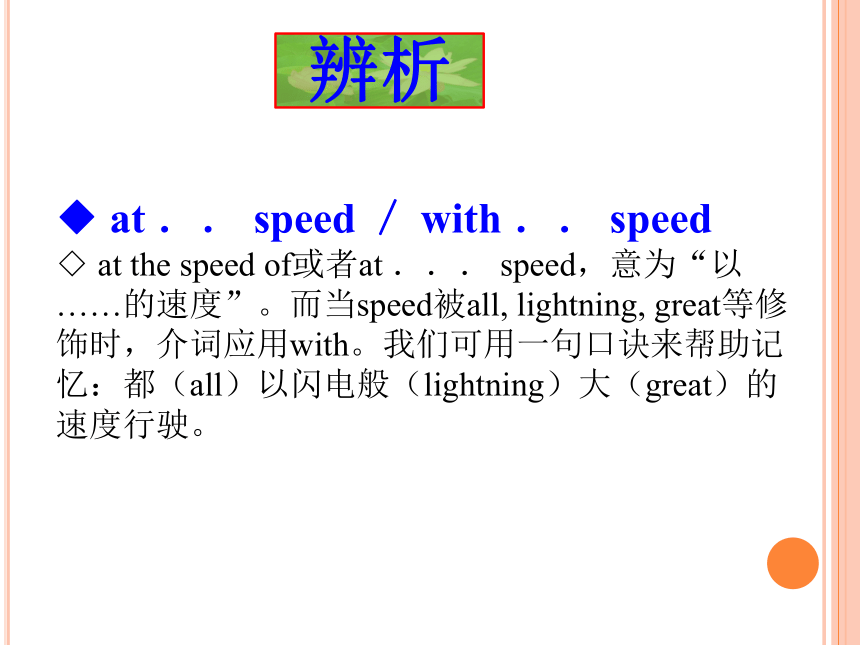
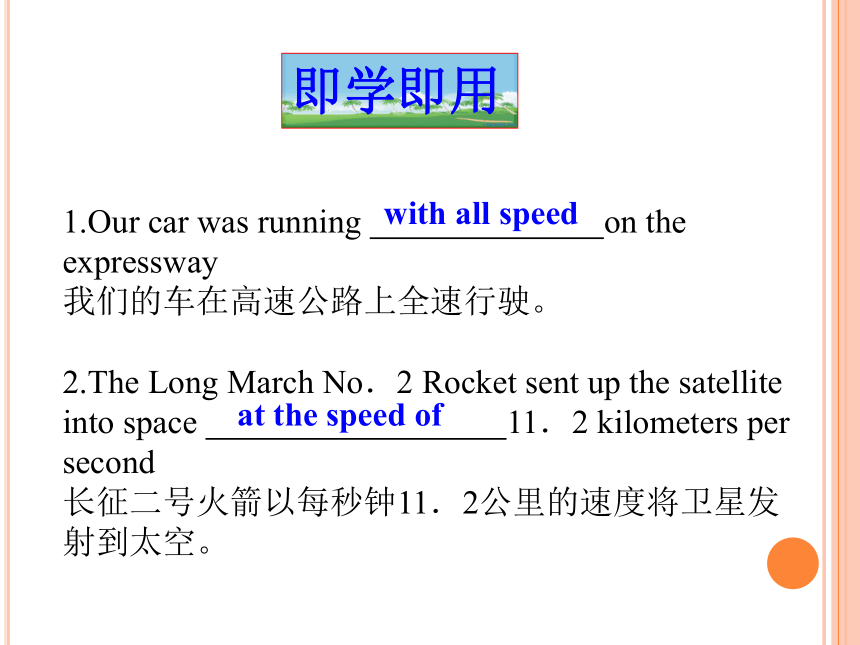
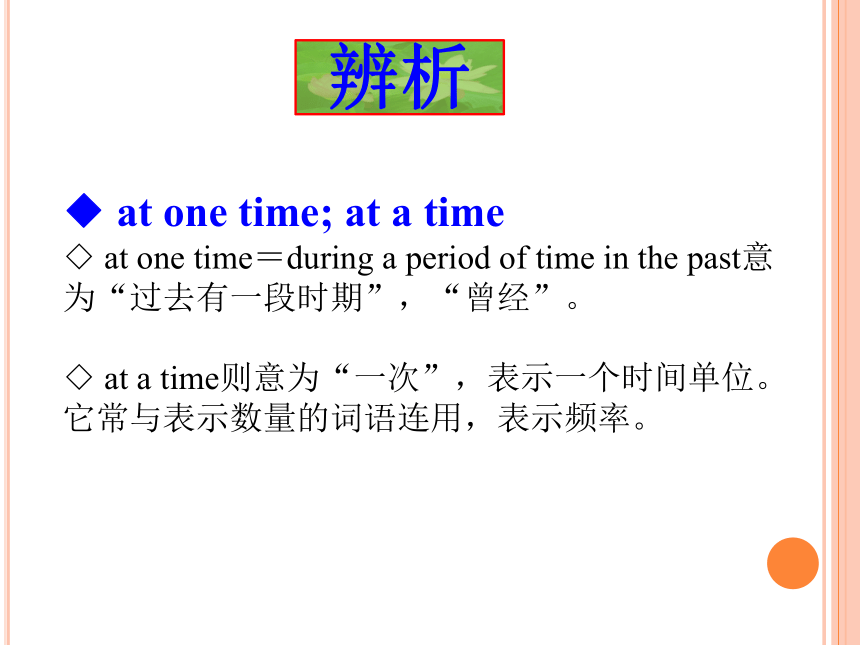
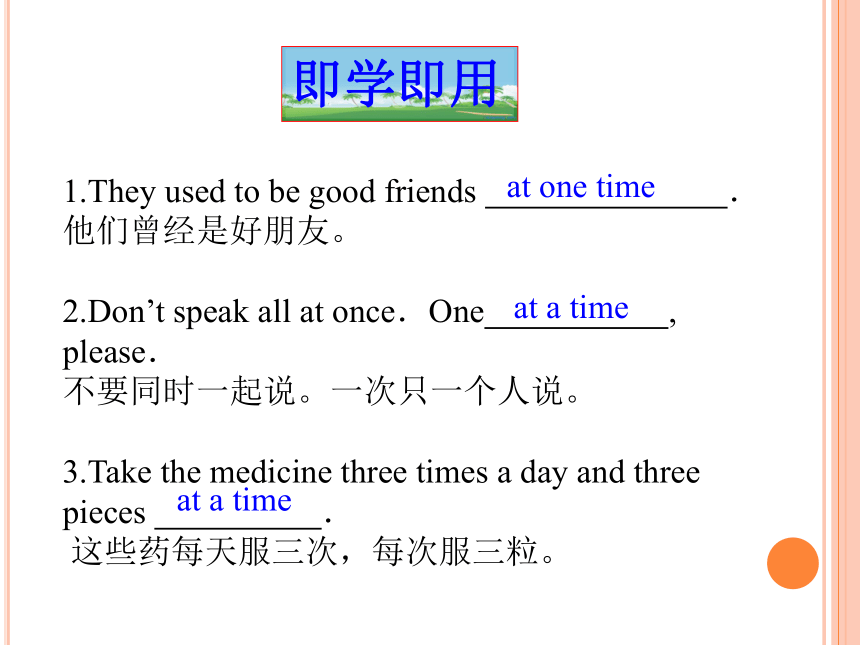

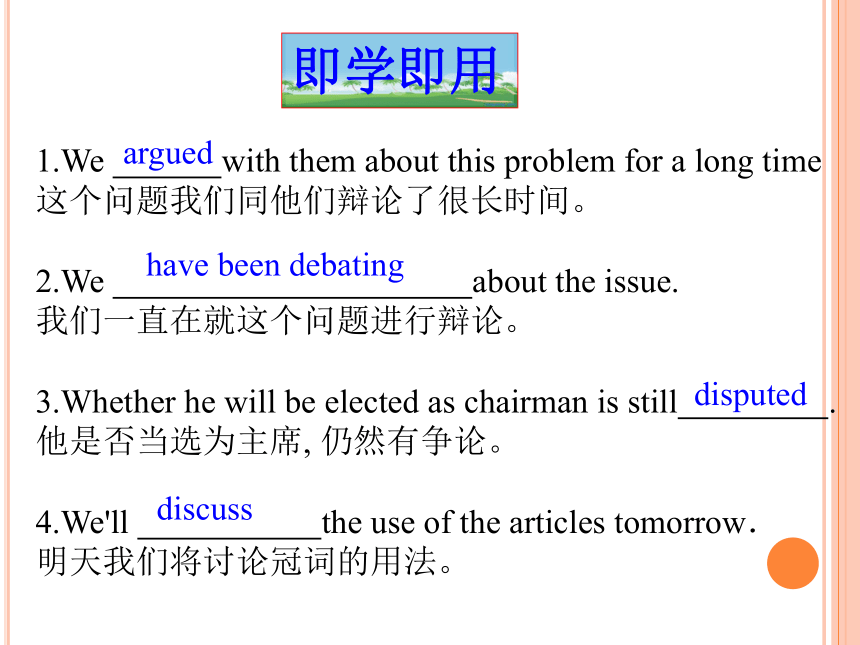

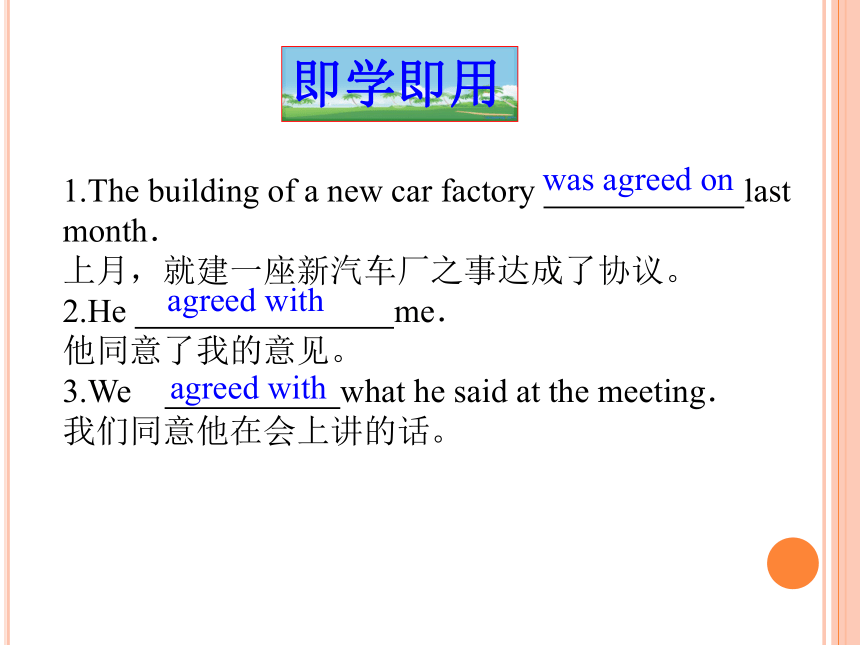

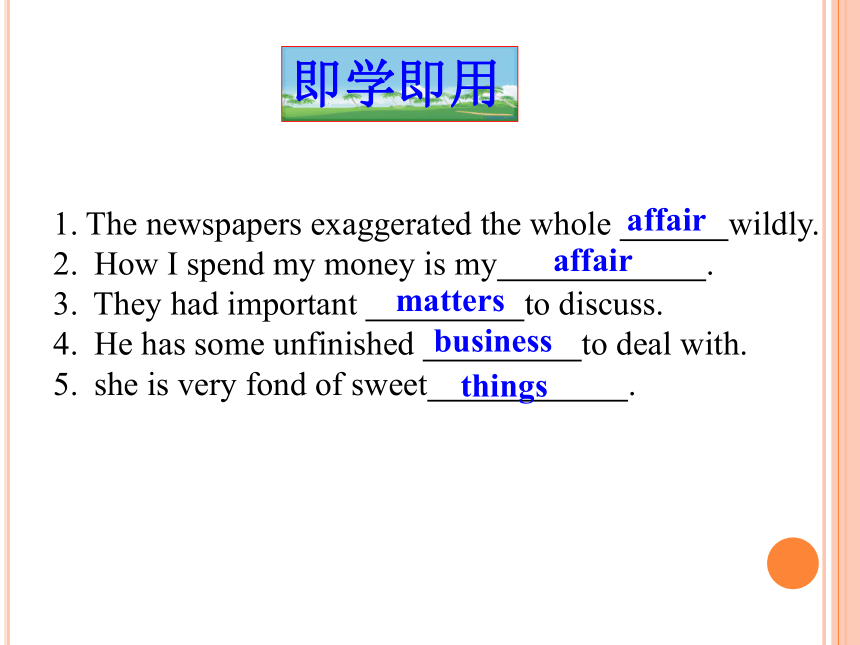
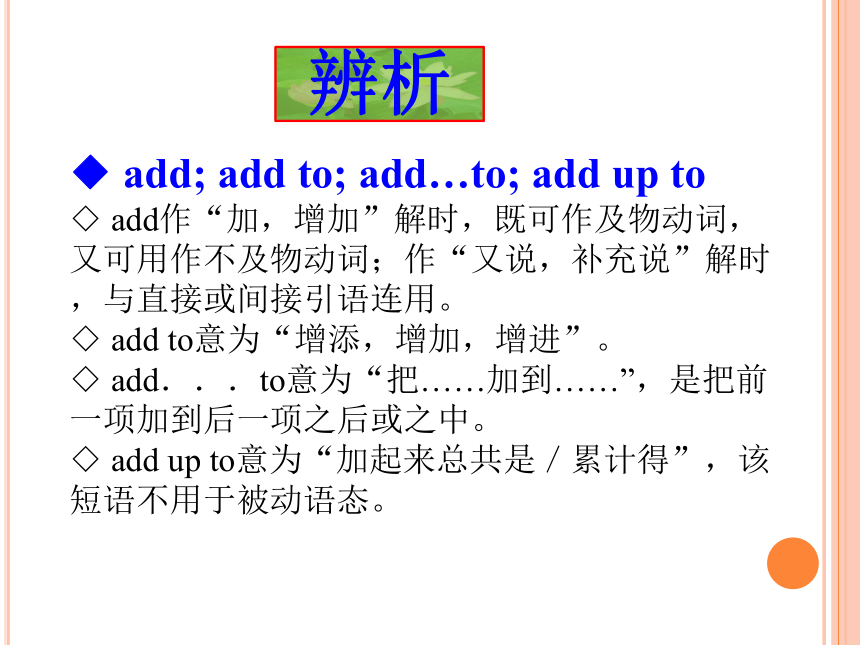
文档简介
(共30张PPT)
高考常用词语辨析
◆ at .. speed / with .. speed
◇ at the speed of或者at ... speed,意为“以……的速度”。而当speed被all, lightning, great等修饰时,介词应用with。我们可用一句口诀来帮助记忆:都(all)以闪电般(lightning)大(great)的速度行驶。
辨析
即学即用
1.Our car was running on the expressway
我们的车在高速公路上全速行驶。
2.The Long March No.2 Rocket sent up the satellite into space 11.2 kilometers per second
长征二号火箭以每秒钟11.2公里的速度将卫星发射到太空。
with all speed
at the speed of
辨析
◆ at one time; at a time
◇ at one time=during a period of time in the past意为“过去有一段时期”,“曾经”。
◇ at a time则意为“一次”,表示一个时间单位。它常与表示数量的词语连用,表示频率。
1.They used to be good friends .
他们曾经是好朋友。
2.Don’t speak all at once.One , please.
不要同时一起说。一次只一个人说。
3.Take the medicine three times a day and three pieces .
这些药每天服三次,每次服三粒。
即学即用
at one time
at a time
at a time
辨析
◆ argue debate dispute discuss
都含“辩论”的意思。
◇ argue 着重“说理”、“论证”和“企图说服”,另外,argue同with搭配,其后接人;与about连用,其后接事物。
◇ debate 着重“双方各述己见”, 内含“交锋”的意思,
◇ dispute 指“激烈争辩”, 含有“相持不下”或“未得解决”之意
◇ discuss是指认真交换自己的意见或看法的“讨论”。
1.We with them about this problem for a long time
这个问题我们同他们辩论了很长时间。
2.We about the issue.
我们一直在就这个问题进行辩论。
3.Whether he will be elected as chairman is still .
他是否当选为主席, 仍然有争论。
4.We'll the use of the articles tomorrow.
明天我们将讨论冠词的用法。
即学即用
argued
have been debating
disputed
discuss
辨析
◆ agree on;agree with
◇ agree on作“就……取得一致意见”解。
◇ agree with作“同意某人的意见”解,其后可跟表示人的名词或代词,也可跟表示“意见”或“说的话”的名词或从句。
1.The building of a new car factory last month.
上月,就建一座新汽车厂之事达成了协议。
2.He me.
他同意了我的意见。
3.We what he said at the meeting.
我们同意他在会上讲的话。
即学即用
was agreed on
agreed with
agreed with
◆ affair; thing; matter; business
◇ affair意为“事情、事件”, 含义较广,泛指已做或待做的事;复数affairs一般指商业事务及政府的日常事务,如财政管理、外交事务等。
◇ thing意为“事情、事物”,不管大事小事、好事坏事均称为thing,一般不能专指事务.复数things还可作“形势”解。
◇ matter侧重指须留心的要事或问题、难题。
◇ business作“事务、事情”解时,一般不能用复数,常常指所指派的任务、责任;有时说的是指派的工作或商业上的买卖活动。
辨析
即学即用
The newspapers exaggerated the whole wildly.
How I spend my money is my .
They had important to discuss.
He has some unfinished to deal with.
she is very fond of sweet .
affair
affair
matters
business
things
◆ add; add to; add…to; add up to
◇ add作“加,增加”解时,既可作及物动词,又可用作不及物动词;作“又说,补充说”解时,与直接或间接引语连用。
◇ add to意为“增添,增加,增进”。
◇ add...to意为“把……加到……”,是把前一项加到后一项之后或之中。
◇ add up to意为“加起来总共是/累计得”,该短语不用于被动语态。
辨析
1.If the tea is too strong, some more hot water
如果茶太浓了,再加点开水。
2.After a short while, he that he would try his best
过了一会儿,他又接着说他会尽力。
3.The bad weather our difficulties.
恶劣的天气增加了我们的困难。
4. two seven, and you will get nine.
七加二等于九。
5.All his school education no more than one year.
他的学校教育加起来不过一年。
即学即用
add
added
added to
Add to
added up to
辨析
◆ above all;after all;at all
◇ above all意为“尤其是”、“首先”、“最重要的是”,常位于句首或句中,作插入语,起强调作用
◇ after all意为“毕竟”、“终究”、“终归”、“到底”,在句中位置较灵活。可位于句首、句中或句末。
◇ at all用于否定句时,意为“丝毫;根本”,用于疑问句时意为“究竟;到底”,用于条件句时,常译为“当真;实在”。用于肯定句中,表示说话人的某种情绪或情感(如怀疑或惊奇等),意为“竟然”等。
即学即用
1.But tell me quickly what I have to do.
可首先快些告诉我该做什么。
2.A clock must keeps good time.
时钟最重要的是必须走得准。
3. ,your birthday is only two weeks away.
毕竟,两周后就是你的生日。
4.He is, ,a small child.
他毕竟还是个小孩子。
above all
above all
After all
after all
辨析
◆ but/however
◇ 这两个连词都有“但是,可是,然而”之意。but连接两个分句或有关部分,表示转折或逻辑上的对比关系,使用最广,口语中更为常见.
◇ however转折意味比but弱,连接的两个分句或有关部分的关系较为松弛,后一部分常起附带说明或衬托作用。however常以插入语形式出现在句子中间,前后用逗号隔开,也可置于句首或句末。
即学即用
1.We love peace we are not afraid of war.
我们热爱和平,但我们并不害怕战争。
2.Later, ,he decided to go.
可是后来他决定去了。
but
however
辨析
◆ bring down; bring back;
bring up; bring in
◇ bring down表示“使倒下”“减少”
“降低(价格、温度)”;
◇ bring back表示“使回想起”“归还”
“带回来”;
◇ bring up表示“呕吐出”、“养育”;
◇ bring in表示“把..引进来”“赚入”
“获利”、“把..拿进来”“吸收”。
即学即用
Her singing _____ memories of my mother.
2) They also ____ some words from their own languages.
3) The wind _ ___ a number of trees.
4) He _____ all he had eaten.
5) Can you try to get them to ____ the price﹖
6) All library books must be ____ before June 25 .
7) Mr White _ ___ $500 a week.
8) You must manage to _____ the temperature.
brings back
brought in
brought down
brought up
bring down
brought back
is bringing in
bring down
辨析
◆ bring on;bring in;bring out
◇ bring on 使发生;引起;端上(饭菜)。
◇ bring in 引来;引进;吸收。如:
◇ bring out 取出;说出;阐明;出版。
即学即用
1.Tom often meals and his brother,Jim picks up the dishes after meals.
汤姆常常端上饭菜,而他弟弟吉姆饭后收拾碗碟。
2.The sudden cold weather his cold again. 天气突然变冷,使他再次感冒。
3.His new business 1,000 dollars.
他的新生意使他赚了一千美元。
brings on
brought on
brings in
4.We also some words from English.
我们也从英语中吸收了一些词汇。
5.He his gun and pointed at me.
他掏出枪来指着我。
6. the meaning more clearly.
请把意思讲清楚些。
7.They have a set of children’s books.
他们出版了一套儿童读物。
即学即用
brought in
brought out
Bring out
brought out
◆ break up; break down; break out; break into; break in; break away; break through
◇ break up表示“打碎”、“变坏”、“分解”、“终止”、“破裂”。
◇ break down表示“瓦解”、“分解”、“失败”、“出故障”、“破坏”、“拆毁”。
◇ break out表示“爆发”、“突然发生”。
辨析
◇ break into表示“强行进入”、“闯入”、“破门而入”、“打断(谈话、讨论)”、“突然……起来”。
◇ break in表示“闯入”、“打断”、“插嘴”,其中in是副词。
◇ break away表示“脱逃”、“脱离”、“突然离开”、“革除”、“戒除”,常与from连用。
◇ break through表示“战胜”、“突围”、“穿过……而出现”、“突破”。
辨析
即学即用
①He said his computer _____.
②Those old cars will be _ ___ for scrap(废铁).
③Last night somebody ____ Mr Brown's house and took away many things.
④A fire ____ after we had gone home.
⑤The boy often ____ while his parents are speaking.
had broken down
broken up
broke into
broke out
breaks in
即学即用
⑥You must ____ from bad habits.
⑦After the heavy rain the sun ____ the clouds
⑧A thief ____ and stole a lot of things last night
⑨Tom ____the motor bike which he bought five years ago.
⑩The ice began to ____ on the river.
break away
broke through
broke in
broke down
break up
辨析
◆ blow down; blow in; blow off; blow over
blow down表示“吹倒”、“刮倒”;
blow in表示“吹进”、“吹入”;
blow off表示“吹掉”、“炸掉”、“发泄”;
blow over表示“?暴风雨 吹散”“过去”
“结束”。
即学即用
The high winds yesterday _____ thousands of trees.
2) We sometimes had quarrels, but they soon _____.
3) I had my hat __ __ by the wind.
4) A lot of dust __ __.You must clear it away.
blew down
blew over
blown off
has blown in
◆ wear;have on;put on;dress;(be)in+颜色(服装、眼镜等)
◇ wear主要用于穿衣服、戴眼镜(手套、首饰、帽)等,以强调“穿(戴)着”的状态
◇ have on作“穿(戴)着”解,同wear一样,也表状态,但不用于进行时态。
◇ put on着重强调“穿(戴)上”的动作。
◇ dress既可作及物动词,又可作不及物动词,所接宾语是人而不是衣、帽等物。
◇ “(be)in+颜色或服装、眼镜等”也表示“穿着”的状态,在句中作表语或定语。
辨析
1.Xiao Wang a white shirt today
(=Xiao Wang a white shirt today.)
小王今天穿着一件白衬衫。
2.I like to when I go out in winter.
冬天,我喜欢外出时戴上帽子。
3.The nurses white.
护士穿着白衣服。
4.He is today.
他今天穿着制服。
has on
is wearing
put on my hat
are dressed in
in uniform
即学即用
高考常用词语辨析
◆ at .. speed / with .. speed
◇ at the speed of或者at ... speed,意为“以……的速度”。而当speed被all, lightning, great等修饰时,介词应用with。我们可用一句口诀来帮助记忆:都(all)以闪电般(lightning)大(great)的速度行驶。
辨析
即学即用
1.Our car was running on the expressway
我们的车在高速公路上全速行驶。
2.The Long March No.2 Rocket sent up the satellite into space 11.2 kilometers per second
长征二号火箭以每秒钟11.2公里的速度将卫星发射到太空。
with all speed
at the speed of
辨析
◆ at one time; at a time
◇ at one time=during a period of time in the past意为“过去有一段时期”,“曾经”。
◇ at a time则意为“一次”,表示一个时间单位。它常与表示数量的词语连用,表示频率。
1.They used to be good friends .
他们曾经是好朋友。
2.Don’t speak all at once.One , please.
不要同时一起说。一次只一个人说。
3.Take the medicine three times a day and three pieces .
这些药每天服三次,每次服三粒。
即学即用
at one time
at a time
at a time
辨析
◆ argue debate dispute discuss
都含“辩论”的意思。
◇ argue 着重“说理”、“论证”和“企图说服”,另外,argue同with搭配,其后接人;与about连用,其后接事物。
◇ debate 着重“双方各述己见”, 内含“交锋”的意思,
◇ dispute 指“激烈争辩”, 含有“相持不下”或“未得解决”之意
◇ discuss是指认真交换自己的意见或看法的“讨论”。
1.We with them about this problem for a long time
这个问题我们同他们辩论了很长时间。
2.We about the issue.
我们一直在就这个问题进行辩论。
3.Whether he will be elected as chairman is still .
他是否当选为主席, 仍然有争论。
4.We'll the use of the articles tomorrow.
明天我们将讨论冠词的用法。
即学即用
argued
have been debating
disputed
discuss
辨析
◆ agree on;agree with
◇ agree on作“就……取得一致意见”解。
◇ agree with作“同意某人的意见”解,其后可跟表示人的名词或代词,也可跟表示“意见”或“说的话”的名词或从句。
1.The building of a new car factory last month.
上月,就建一座新汽车厂之事达成了协议。
2.He me.
他同意了我的意见。
3.We what he said at the meeting.
我们同意他在会上讲的话。
即学即用
was agreed on
agreed with
agreed with
◆ affair; thing; matter; business
◇ affair意为“事情、事件”, 含义较广,泛指已做或待做的事;复数affairs一般指商业事务及政府的日常事务,如财政管理、外交事务等。
◇ thing意为“事情、事物”,不管大事小事、好事坏事均称为thing,一般不能专指事务.复数things还可作“形势”解。
◇ matter侧重指须留心的要事或问题、难题。
◇ business作“事务、事情”解时,一般不能用复数,常常指所指派的任务、责任;有时说的是指派的工作或商业上的买卖活动。
辨析
即学即用
The newspapers exaggerated the whole wildly.
How I spend my money is my .
They had important to discuss.
He has some unfinished to deal with.
she is very fond of sweet .
affair
affair
matters
business
things
◆ add; add to; add…to; add up to
◇ add作“加,增加”解时,既可作及物动词,又可用作不及物动词;作“又说,补充说”解时,与直接或间接引语连用。
◇ add to意为“增添,增加,增进”。
◇ add...to意为“把……加到……”,是把前一项加到后一项之后或之中。
◇ add up to意为“加起来总共是/累计得”,该短语不用于被动语态。
辨析
1.If the tea is too strong, some more hot water
如果茶太浓了,再加点开水。
2.After a short while, he that he would try his best
过了一会儿,他又接着说他会尽力。
3.The bad weather our difficulties.
恶劣的天气增加了我们的困难。
4. two seven, and you will get nine.
七加二等于九。
5.All his school education no more than one year.
他的学校教育加起来不过一年。
即学即用
add
added
added to
Add to
added up to
辨析
◆ above all;after all;at all
◇ above all意为“尤其是”、“首先”、“最重要的是”,常位于句首或句中,作插入语,起强调作用
◇ after all意为“毕竟”、“终究”、“终归”、“到底”,在句中位置较灵活。可位于句首、句中或句末。
◇ at all用于否定句时,意为“丝毫;根本”,用于疑问句时意为“究竟;到底”,用于条件句时,常译为“当真;实在”。用于肯定句中,表示说话人的某种情绪或情感(如怀疑或惊奇等),意为“竟然”等。
即学即用
1.But tell me quickly what I have to do.
可首先快些告诉我该做什么。
2.A clock must keeps good time.
时钟最重要的是必须走得准。
3. ,your birthday is only two weeks away.
毕竟,两周后就是你的生日。
4.He is, ,a small child.
他毕竟还是个小孩子。
above all
above all
After all
after all
辨析
◆ but/however
◇ 这两个连词都有“但是,可是,然而”之意。but连接两个分句或有关部分,表示转折或逻辑上的对比关系,使用最广,口语中更为常见.
◇ however转折意味比but弱,连接的两个分句或有关部分的关系较为松弛,后一部分常起附带说明或衬托作用。however常以插入语形式出现在句子中间,前后用逗号隔开,也可置于句首或句末。
即学即用
1.We love peace we are not afraid of war.
我们热爱和平,但我们并不害怕战争。
2.Later, ,he decided to go.
可是后来他决定去了。
but
however
辨析
◆ bring down; bring back;
bring up; bring in
◇ bring down表示“使倒下”“减少”
“降低(价格、温度)”;
◇ bring back表示“使回想起”“归还”
“带回来”;
◇ bring up表示“呕吐出”、“养育”;
◇ bring in表示“把..引进来”“赚入”
“获利”、“把..拿进来”“吸收”。
即学即用
Her singing _____ memories of my mother.
2) They also ____ some words from their own languages.
3) The wind _ ___ a number of trees.
4) He _____ all he had eaten.
5) Can you try to get them to ____ the price﹖
6) All library books must be ____ before June 25 .
7) Mr White _ ___ $500 a week.
8) You must manage to _____ the temperature.
brings back
brought in
brought down
brought up
bring down
brought back
is bringing in
bring down
辨析
◆ bring on;bring in;bring out
◇ bring on 使发生;引起;端上(饭菜)。
◇ bring in 引来;引进;吸收。如:
◇ bring out 取出;说出;阐明;出版。
即学即用
1.Tom often meals and his brother,Jim picks up the dishes after meals.
汤姆常常端上饭菜,而他弟弟吉姆饭后收拾碗碟。
2.The sudden cold weather his cold again. 天气突然变冷,使他再次感冒。
3.His new business 1,000 dollars.
他的新生意使他赚了一千美元。
brings on
brought on
brings in
4.We also some words from English.
我们也从英语中吸收了一些词汇。
5.He his gun and pointed at me.
他掏出枪来指着我。
6. the meaning more clearly.
请把意思讲清楚些。
7.They have a set of children’s books.
他们出版了一套儿童读物。
即学即用
brought in
brought out
Bring out
brought out
◆ break up; break down; break out; break into; break in; break away; break through
◇ break up表示“打碎”、“变坏”、“分解”、“终止”、“破裂”。
◇ break down表示“瓦解”、“分解”、“失败”、“出故障”、“破坏”、“拆毁”。
◇ break out表示“爆发”、“突然发生”。
辨析
◇ break into表示“强行进入”、“闯入”、“破门而入”、“打断(谈话、讨论)”、“突然……起来”。
◇ break in表示“闯入”、“打断”、“插嘴”,其中in是副词。
◇ break away表示“脱逃”、“脱离”、“突然离开”、“革除”、“戒除”,常与from连用。
◇ break through表示“战胜”、“突围”、“穿过……而出现”、“突破”。
辨析
即学即用
①He said his computer _____.
②Those old cars will be _ ___ for scrap(废铁).
③Last night somebody ____ Mr Brown's house and took away many things.
④A fire ____ after we had gone home.
⑤The boy often ____ while his parents are speaking.
had broken down
broken up
broke into
broke out
breaks in
即学即用
⑥You must ____ from bad habits.
⑦After the heavy rain the sun ____ the clouds
⑧A thief ____ and stole a lot of things last night
⑨Tom ____the motor bike which he bought five years ago.
⑩The ice began to ____ on the river.
break away
broke through
broke in
broke down
break up
辨析
◆ blow down; blow in; blow off; blow over
blow down表示“吹倒”、“刮倒”;
blow in表示“吹进”、“吹入”;
blow off表示“吹掉”、“炸掉”、“发泄”;
blow over表示“?暴风雨 吹散”“过去”
“结束”。
即学即用
The high winds yesterday _____ thousands of trees.
2) We sometimes had quarrels, but they soon _____.
3) I had my hat __ __ by the wind.
4) A lot of dust __ __.You must clear it away.
blew down
blew over
blown off
has blown in
◆ wear;have on;put on;dress;(be)in+颜色(服装、眼镜等)
◇ wear主要用于穿衣服、戴眼镜(手套、首饰、帽)等,以强调“穿(戴)着”的状态
◇ have on作“穿(戴)着”解,同wear一样,也表状态,但不用于进行时态。
◇ put on着重强调“穿(戴)上”的动作。
◇ dress既可作及物动词,又可作不及物动词,所接宾语是人而不是衣、帽等物。
◇ “(be)in+颜色或服装、眼镜等”也表示“穿着”的状态,在句中作表语或定语。
辨析
1.Xiao Wang a white shirt today
(=Xiao Wang a white shirt today.)
小王今天穿着一件白衬衫。
2.I like to when I go out in winter.
冬天,我喜欢外出时戴上帽子。
3.The nurses white.
护士穿着白衣服。
4.He is today.
他今天穿着制服。
has on
is wearing
put on my hat
are dressed in
in uniform
即学即用
